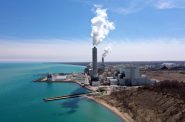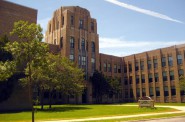How the Domes Can Be Saved
Just as New York’s Central Park was. Create a nonprofit conservancy to revive and restore the domes and Mitchell Park.
Here are some thoughts on the Mitchell Park Domes before they slide back into obscurity and second-tier status, the likely pathway to demolition. Begin with the theme of “facing reality” in thinking about the future – or non-future – of this extraordinary facility.
A good starting point is to make some basic – but often unstated – assumptions explicit, and to test them. The simplest one may be this: Beauty matters! But that’s a little abstract.
Starting with a budget grounded in current “realities” is a dead end. The two most important of these realities are a need for major capital investment, and an “owner,” Milwaukee County, which doesn’t have the available resources to make those investments. This conundrum leads to two potential trajectories: first, accept the decline and eventual closure of The Domes, or, alternatively, reconfigure reality to produce a far better outcome.
There has been widespread criticism of the external consultants hired to produce a long-term Domes plan. Some of that criticism has been misplaced. The goal of the consultants was – or should have been – to produce a plan that got executed, not a “report” with clever graphics. And execution means mobilizing a group of powerful champions around a vision of a better future. And then laying out a path to achieving that vision. The “process” is as important as the product.
In this instance, the vision should have been linked to a solution to the structural problem presented by county ownership and management, and the inability of the county to finance the needed physical and management improvements.
Strategic assumption #2: the Domes can and should be a major local and visitor destination, right up there with the Calatrava museum. Getting there means thinking big, placing a rebuilt Domes within the context of a revitalized Mitchell Park, and making the near South Side Milwaukee’s “green community.” (And, as climate change accelerates and extreme heat becomes a regular occurrence, “green communities” will be public health priorities rather than “nice” ancillary features.)
To succeed, an undertaking on this scale needs a core group whose commitment goes beyond “this makes sense.” It demands a strong and sustained emotional commitment. The belief that this is a big deal and a very big opportunity for Milwaukee. That is why a clear and powerful vision is the foundational starting point.
Assumption #4: the money assumption. But, but, but…. As everyone knows, you can’t solve problems by throwing money at them. Except that you can. You just have to throw the money in the right direction, and with accountability for results.
For the Mitchell Park Domes, there is a directly relevant model: New York City’s Central Park, another lost cause that people had given up on, written off, and cringed about when dollar amounts for restoration were tossed about.
Four decades ago, Central Park was a civic embarrassment, an unfunny joke on late night television, and a mostly empty, dangerous and ill-maintained wasteland. Lawns were barren, paths unpassable, lamps and benches broken and graffiti covered, all the results of decades of ingrained pessimism, disinvestment and decline.
Today, Central Park is the pre-eminent urban park in the world. No longer empty, it now attracts more than 40 million visitors a year, a mix of New Yorkers and tourists. It is beautiful, well-maintained, a center of activity, and peaceful.
How this transformation came about has direct relevance to the Domes story. It started with a group of people who refused to accept decline as inevitable, and who had a vision for a revitalized park and the role it could play in the community. They also knew that the City of New York was essentially broke, and that the New York City Department of Parks was incapable of fulfilling that vision.
A relevant mini-case study. Bethesda Fountain and its plaza are spectacular centerpieces in Central Park. Like many things, the fountain had not worked and been dry for decades. The Parks Department engineers told a newly appointed commissioner that it would cost a fortune to restore it.
Becoming increasingly suspicious of the relentlessly pessimistic advice that he was getting, the commissioner called his family plumber. He got him a pass and told him to look at the fountain and figure out what it would take to get it working again. A few days later, the plumber called the commissioner’s office with his report: “Commissioner, I fixed the fountain.” The cost was something like $50, and the fountain has worked ever since. For some reason, this story comes to mind whenever someone says that it would cost a fortune, or it would be impossible, to restore the regal sunken gardens in front of the Domes.
The contribution of this restoration to New York City’s life, economy and image is incalculable. It is a failure of imagination to not see the similarly transformative potential of a restored Domes as the anchor for much broader progress and community economic development.
Final Assumption: Restoring the Domes would not cost hundreds of millions of dollars, but Milwaukee County won’t be able to commit whatever it would take. Key messages: create a conservancy-like entity; don’t rely on exotic financial/tax devices; and present a vision and action plans that encompass the Domes, Mitchell Park and the surrounding community.
Then, contrary to the notion of starting with a truncated budget, find private, corporate and philanthropic dollars to partner with local groups to implement a solid strategic and business plan. A simple example: think of the price for corporate naming rights for the three spectacularly restored and lit Domes, along with a restored garden and ancillary facilities.
Final thoughts. Contrary to a theme in the recent article, a Domes initiative is not back to “square one.” There have been important lessons learned, but it would be unfortunate to learn the wrong ones. The most important lesson: there is no alternative to thinking big.
And, the starting point: create a conservancy-like entity with a high-level board, and produce strategic and business plans that can serve as the vehicle for raising – and investing – lots of money in a far brighter future.
We know it is doable. How do we know? Because it has been done.
Frank Schneiger is founder and president of Frank Schneiger and Associates, a management planning and consulting firm, and has held top government positions for both the city of New York and the Commonwealth of Massachusetts.
More about the Future of The Domes
- Milwaukee County Board Reaffirms Commitment to Redevelopment and Restoration of Mitchell Park Domes - County Board Chairwoman Marcelia Nicholson - Sep 18th, 2025
- MKE County: Committee Cautiously Approves Domes Development - Graham Kilmer - Sep 3rd, 2025
- MKE County: Crowley Approves $30 Million for Domes - Graham Kilmer - Jul 30th, 2025
- County Executive Crowley, Chairwoman Nicholson Sign Legislation Approving Plan to Redevelop and Restore Mitchell Park Domes - David Crowley - Jul 30th, 2025
- MKE County: Board Approves $30 Million Commitment For Domes - Graham Kilmer - Jul 24th, 2025
- Why Mitchell Park Needs The Domes - Graham Kilmer - Jul 22nd, 2025
- MKE County: Parks Committee Backs $30 Million Domes Deal - Graham Kilmer - Jul 8th, 2025
- MKE County: Domes Plan Requires $30 Million From County - Graham Kilmer - Jul 2nd, 2025
- MKE County: Domes Project Lining Up Key Financing Component - Graham Kilmer - Feb 28th, 2025
- MKE County: Supervisor Adds Domes Project to 2025 Budget - Graham Kilmer - Oct 24th, 2024
Read more about Future of The Domes here
Op-Ed
-
Unlocking Milwaukee’s Potential Through Smart Zoning Reform
 Jul 5th, 2024 by Ariam Kesete
Jul 5th, 2024 by Ariam Kesete
-
We Energies’ Natural Gas Plans Are A Mistake
 Jun 28th, 2024 by John Imes
Jun 28th, 2024 by John Imes
-
Milwaukee Needs New Kind of School Board
 Jun 26th, 2024 by Jordan Morales
Jun 26th, 2024 by Jordan Morales





















